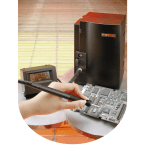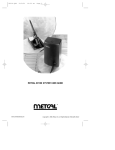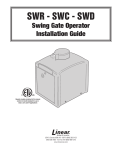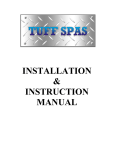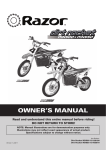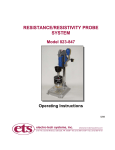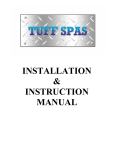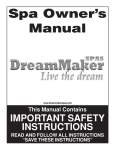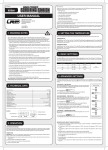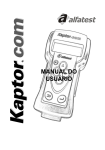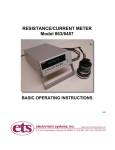Download METCAL MX500 SYSTEM USER GUIDE - E
Transcript
MX500-Universal.qxd 3/29/99 3:57 PM Page 1 Test Equipment Depot - 800.517.8431 - 99 Washington Street Melrose, MA 02176 - TestEquipmentDepot.com METCAL MX500 SYSTEM USER GUIDE BENUTZERHANDBUCH FÜR SYSTEM METCAL MX500 MANUEL D’UTILISATION DU SYSTEME METCAL MX-500 MANUALE DI ISTRUZIONI PER L’USO DI METCAL MX-500 Copyright © 1998, Metcal, Inc. All Rights Reserved 7027-0400 Rev A MX500-Universal.qxd 3/29/99 3:57 PM Page 2 MX500-Universal.qxd 3/29/99 3:57 PM Page 3 METCAL MX500 SYSTEM USER GUIDE POWER SUPPLY SYSTEM SET UP AND OPERATION . . . . . . . . . . . . . . . . . . . . . . . . . . . . . . . . . . . . . . . . . . . . . . 2 NO CALIBRATION NEEDED . . . . . . . . . . . . . . . . . . . . . . . . . . . . . . . . . . . . . . . . . . . . . . . . . . . . 3 SOLDER/REWORK HANDPIECE CHOOSING THE CORRECT TIP FOR THROUGH-HOLE SOLDERING AND SMT TOUCH-UP . . . . . . . . . 4 CHOOSING THE CORRECT TIP FOR SMT REMOVAL . . . . . . . . . . . . . . . . . . . . . . . . . . . . . . . . . . . 5 INSERTING TIP CARTRIDGES INTO THE SOLDER/REWORK HANDPIECE. . . . . . . . . . . . . . . . . . . . . 6 TALON HANDPIECE SELECTING TIP CARTRIDGES FOR THE TALON HANDPIECE . . . . . . . . . . . . . . . . . . . . . . . . . . . . . 7 INSERTING AND REPLACING TIP CARTRIDGES . . . . . . . . . . . . . . . . . . . . . . . . . . . . . . . . . . . . . 7 TALON OPERATION . . . . . . . . . . . . . . . . . . . . . . . . . . . . . . . . . . . . . . . . . . . . . . . . . . . . . . . . . 7 DESOLDERING HANDPIECE ATTACHING THE AIR HOSE TO THE DESOLDER HANDPIECE . . . . . . . . . . . . . . . . . . . . . . . . . . . . 8 PREPARING THE DESOLDER HANDPIECE . . . . . . . . . . . . . . . . . . . . . . . . . . . . . . . . . . . . . . . . . 8 INSERTING FILTERS IN THE DESOLDER HANDPIECE . . . . . . . . . . . . . . . . . . . . . . . . . . . . . . . . . 8 CHOOSING THE CORRECT DESOLDER CARTRIDGE . . . . . . . . . . . . . . . . . . . . . . . . . . . . . . . . . . . 9 INSERTING/REPLACING TIP CARTRIDGES INTO THE DESOLDER HANDPIECE . . . . . . . . . . . . . . . . 10 MAINTENANCE: CLEANING THE COLLECTION CHAMBER . . . . . . . . . . . . . . . . . . . . . . . . . . . . . 10 MAINTENANCE: CLEANING THE VENTURI . . . . . . . . . . . . . . . . . . . . . . . . . . . . . . . . . . . . . . . . 11 MAINTENANCE: REPLACING THE VENTURI . . . . . . . . . . . . . . . . . . . . . . . . . . . . . . . . . . . . . . . 11 MAINTENANCE: CLEANING THE DESOLDERING HANDLE. . . . . . . . . . . . . . . . . . . . . . . . . . . . . . 11 MAINTENANCE: CLEANING THE WORKSTAND . . . . . . . . . . . . . . . . . . . . . . . . . . . . . . . . . . . . . 11 MAINTENANCE: REPLACING THE SWIVEL BUSHING . . . . . . . . . . . . . . . . . . . . . . . . . . . . . . . . 12 MAINTENANCE: REPLACING THE UPPER CHAMBER . . . . . . . . . . . . . . . . . . . . . . . . . . . . . . . . 12 MAINTENANCE: REPLACING CARTRIDGE SEALS . . . . . . . . . . . . . . . . . . . . . . . . . . . . . . . . . . . 13 MAINTENANCE: REPLACING CHAMBER SEALS . . . . . . . . . . . . . . . . . . . . . . . . . . . . . . . . . . . . 13 TROUBLESHOOTING TIP CARTRIDGE WON’T HEAT OR ONE TALON TIP SEEMS TO HEAT POORLY . . . . . . . . . . . . . . . . 14 DESOLDERING TOOL DOES NOT REMOVE SOLDER. . . . . . . . . . . . . . . . . . . . . . . . . . . . . . . . . . . 15 POWER SUPPLY CYCLES ON AND OFF OR WILL NOT TURN ON . . . . . . . . . . . . . . . . . . . . . . . . . 16 EXTENDING TIP LIFE . . . . . . . . . . . . . . . . . . . . . . . . . . . . . . . . . . . . . . . . . . . . . . . . . . . . . . . 16 DETINNED TIPS . . . . . . . . . . . . . . . . . . . . . . . . . . . . . . . . . . . . . . . . . . . . . . . . . . . . . . . . . . 17 SAFETY WITH THE METCAL SYSTEM . . . . . . . . . . . . . . . . . . . . . . . . . . . . . . . . . . . . . . . . . . . 17 SPECIFICATIONS. . . . . . . . . . . . . . . . . . . . . . . . . . . . . . . . . . . . . . . . . . . . . . . . . . . . . . . . . . 18 WARRANTY . . . . . . . . . . . . . . . . . . . . . . . . . . . . . . . . . . . . . . . . . . . . . . . . . . . . . . . . . . . . . 19 ® Copyright © 1998, Metcal, Inc. All Rights Reserved 7027-0400 Rev A MX500-Universal.qxd 3/29/99 3:57 PM Page 2 SYSTEM SET UP AND OPERATION The MX-500P Power Supply is a two port switchable 40-watt power supply with a separate power cord. The MX-500P Power Supply is an upgraded version of the Metcal STSS-PS2E. Some of the additional features in this upgrade are described below. AUTO SHUT-OFF Like the STSS-PS2E, the MX-500P is equipped with a ground sensing feature. The AMBER LIGHT illuminates when there is any break in the ground. To reset, turn the power supply off and back on. If the ground has not been re-established, the power supply will remain off. POWER SWITCH GREEN POWER ON LIGHT AMBER AUTO-OFF LIGHT OVERRIDE SWITCH PORT SELECTOR PORT INDICATOR PORTS TIME-OUT FEATURE Your MX-500P comes with a time-out FRONT VIEW SIDE VIEW feature designed to maximize the life of your tip cartridges. The time-out feature works by detecting a load difference at the tip and sensing whether the tip cartridge has been used during the past 25-30 minutes. If no load change is sensed, the power supply shuts off. This is indicated by the GREEN LIGHT going off. To reset, turn the power supply off and back on. OVERRIDE SWITCH Because the time-out feature works off a load difference, sometimes the power supply may not sense very light loads. If, for instance, an operator is soldering 30 gauge wire with an STTC-522 (no sponge wipe), the power supply may shut down after 30 minutes. To ensure operator satisfaction, Metcal has equipped the MX-500P with an OVERRIDE SWITCH. To disengage the time-out feature, unscrew the set screw several turns with the provided Allen wrench. To re-engage, turn off the power supply and screw the set screw clockwise until it feels tight. When the power supply is turned back on, the time-out feature will be restored. SETTING UP THE SYSTEM To set up the power supply, plug the power cord into the three F-CONNECTOR pronged outlet on the back of the power supply. Plug the cord into an appropriately rated outlet. Turn the silver connector at the back of the handle cord assembly counterclockwise until it is completely flush with the back of the black handle cord assembly. Then, attach the connector to the port at the front of the power supply by pushing the connector assembly onto the F-connector and turning the silver handle cord connector clockwise until it is finger tight. You can attach an additional handpiece into the other port, or leave the port open for the addition of another handpiece later. If desired, label the ports according to handpiece type. Place tool(s) into the appropriate workstand(s). Select a tip cartridge and insert it into the handpiece. Power the system on by pressing the switch on the top left hand side to the “on” position. The green light should come on. Move the PORT SELECTOR to the port which corresponds to the handpiece you wish to use. The PORT INDICATOR will be next to the appropriate port. 2 Copyright © 1998, Metcal, Inc. All Rights Reserved 7027-0400 Rev A MX500-Universal.qxd 3/29/99 3:57 PM Page 3 NO CALIBRATION REQUIRED METCAL® SMARTHEAT® SOLDERING, DESOLDERING, AND REWORK SYSTEMS DO NOT REQUIRE SYSTEM CALIBRATION FOR TEMPERATURE. A Metcal System is comprised of a power supply with handle/cord assembly and a tip cartridge. Each cartridge is equipped with a self-regulating heater, which senses its own temperature and tightly maintains its pre-set idle temperature for the life of the cartridge. The heater temperature is set by the atomic structure of the heater material. It cannot be adjusted, and does not require any adjustment. The power supply with handle/cord assembly does not contain the heater or any tip temperature sensors, but simply provides the current to the heater. Any expected variability or drift in the power supply over its life does not adversely affect its ability to maintain the necessary current to the heater. There are no adjustments to be made. The term calibration implies that because of inherent shift over time in a system, periodic adjustment must be made to maintain performance. Calibration schedules are normally based on anticipating when an out-of-tolerance condition will occur and calibrating or adjusting prior to this event. In a Metcal System, there is nothing to adjust, so the system cannot be changed from its initial state. Therefore, NO CALIBRATION is required. Metcal tip cartridges control temperature inherently by the physical properties of their materials to dynamically respond to loads. Those companies or individuals requiring periodic verification of system performance may do so in the following ways: • Measure the performance of the system in 'time required to solder a defined number of loads', or • Measure tip idle temperature as it equates to this performance, or • Observe start up and idle power with a Metcal Net Power Meter. Copyright © 1998, Metcal, Inc. All Rights Reserved 7027-0400 Rev A 3 MX500-Universal.qxd 3/29/99 3:57 PM Page 4 CHOOSING THE CORRECT TIP CARTRIDGE FOR THROUGH-HOLE SOLDERING AND SMT TOUCH-UP Proper tip cartridge selection is important for getting the best results from your Metcal System. Choosing the right tip will maximize your soldering performance at the lowest possible temperature, and will ensure you the longest tip life possible. CHOOSE THE CORRECT GEOMETRY For STTC soldering tips, you want to pick a tip geometry which will maximize contact with the connection. A flat, blunt tip will transfer more heat than a fine, pointed one. Choosing the largest tip possible will both improve performance (enabling you to get more heat at lower temperatures), and enhance tip life. CORRECT TOO SMALL TOO LARGE CHOOSE THE CORRECT SERIES Each Metcal cartridge is specially designed for high power delivery, which means that you can often solder with a Metcal cartridge at a temperature 100°F or more lower than with a conventional iron. Since Metcal tip cartridges sense thermal loads and respond to them, you need only approximate the size of the loads you will be working with. Start with a lower temperature, going to a higher temperature only when necessary. FOR MOST APPLICATIONS HEAVY GROUND PLANES WORKING WITH NO-CLEANS THERMALLY SENSITIVE APPLICATIONS 600 SERIES 700 SERIES 500 SERIES 500 SERIES LOT 1212 LOT CODE STTC-036 SERIES/STYLE WHEN SOLDERING MULTI-LEAD PACKAGES Let Metcal’s Multi-lead Soldering (“hoof”) tip cartridge or one of Metcal’s blade tips do the work for you! It’s faster than laboriously soldering point to point. It’s safer than drag soldering with a bent hook tip, which can abrade leads and shorten tip life. For more information, call your Authorized Distributor. BLADE 4 M U LT I - L E A D SOLDERING Copyright © 1998, Metcal, Inc. All Rights Reserved 7027-0400 Rev A MX500-Universal.qxd 3/29/99 3:57 PM Page 5 CHOOSING THE CORRECT TIP CARTRIDGE FOR SMT REMOVAL CHOOSE THE CORRECT GEOMETRY First, measure the dimensions of your component. Then, using the SMTC charts which are available from your local distributor or on Metcal’s web page (www.metcal.com), look up your component description, and cross match it to the dimensions listed (sometimes components with the same description can have different dimensions). If this doesn’t work, try looking up the dimensions of other types of components; one of them may work. The tip you choose must match your component. A “near fit” is not good enough for most applications. The leads must be contacted on all sides, ensuring even performance. SLOT TUNNEL QUAD QUAD DUAL QUAD* THE SIMPLEST WAYS TO GET THE RIGHT TIP Many customers have said that measuring their components and matching them up to a chart can be difficult. That’s why Metcal developed the SMTC Tip Template Guide. The SMTC Tip Template is a series of ESD-safe, clear plastic templates in an easy-to-use book. Look up what type of component you have, and turn to one of our templates. Lay the template over the component, and, if it fits and has the correct lead count, you’ve found your tip. There’s also an outline of each tip at the edge of the template, so you can turn the template and “try out” the tip on the component. In addition, Metcal has a “tip picker” software program that may be of use to you. Contact your distributor or www.metcal.com for more information. If you are still having problems, your local Metcal Distributor or Representative can help. Please give them a call. CHOOSE THE CORRECT SERIES Each Metcal cartridge is specially designed to deliver high power in response to loads. For this reason, you can often rework with a Metcal cartridge at a temperature 100°F or more lower than with a conventional iron. In Metcal’s tip listing, the recommended Series is included in its own column. If you think you need a different series than recommended, call your Metcal Distributor or Representative. Copyright © 1998, Metcal, Inc. All Rights Reserved 7027-0400 Rev A 5 MX500-Universal.qxd 3/29/99 3:58 PM Page 6 INSERTING TIP CARTRIDGES INTO THE SOLDER/REWORK HANDPIECE 1. Make sure the system is turned off. 2. Insert the tip cartridge into the soldering handpiece by pushing in the “back end” of the cartridge (the end without the tip) as far as it will go. You will feel a slight click as it locks into place THIS NOT THIS REPLACING TIP CARTRIDGES NOTE: EVEN AFTER THE SYSTEM IS TURNED OFF OR TIMED OUT, THE TIP CARTRIDGE MAY BE HOT 1. Make sure the system is turned off. 2. Pull out the cartridge using the Cartridge Removal Pad 3. Push a new cartridge into the handle as discussed above. 4. Push the power switch “on”. The new cartridge should heat up to temperature quickly. DO NOT USE METAL TOOLS SUCH AS PLIERS TO REMOVE TIP CARTRIDGES! 6 Copyright © 1998, Metcal, Inc. All Rights Reserved 7027-0400 Rev A MX500-Universal.qxd 3/29/99 3:58 PM Page 7 SELECTING TIP CARTRIDGES FOR THE TALON HANDPIECE Metcal TATC tip cartridges come in a variety of tip geometries and in two standard temperature ranges (500 Series and 600 Series). To select the correct tip: 1. Use a tip that meets or overextends the length of the lead footprint. 2. Pick the lowest temperature tip cartridge that will accomplish the task. Start with a 500 Series cartridge and switch to a 600 Series only if you need more heat. The temperature series is marked on the shaft. PART NUMBER LOT CODE TATC-504 INSERTION MARK LOT-YDDD TEMPERATURE SERIES INSERTING AND REPLACING TIP CARTRIDGES 1. Push the Power Switch “Off.” 2. THE TIP CARTRIDGE MAY BE HOT. Pull out the cartridge using the black Cartridge Removal Pad included with your system. DO NOT USE METAL TOOLS (PLIERS, ETC) TO REMOVE CARTRIDGES! 3. Push a new cartridge into the solder handle with the Cartridge Pad. Align the flat side of the cartridge shaft with the opening in the handle. Push in the cartridge until it seats. 4. The cartridge is fully seated when the insertion mark is flush with the front of the handle. Do not push past this mark. Both cartridges must be inserted properly. 5. Push the Power Switch “On.” The new tip cartridge will heat up to temperature in less than 20 seconds. INSERTION MARK TALON OPERATION 1. Clean, then tin tips well. 2. Ensure tips contact all leads on device, either the bevel or straight portion of the tip can be used. 3. Squeeze tool. Wait for all leads to reflow. 4. Maintaining pressure, lift component. Copyright © 1998, Metcal, Inc. All Rights Reserved 7027-0400 Rev A 7 MX500-Universal.qxd 3/29/99 3:58 PM Page 8 ATTACHING THE AIR HOSE TO THE DESOLDER HANDPIECE NOTE: SAFETY GLASSES SHOULD BE WORN WHEN WORKING WITH ANY COMPRESSED AIR LINES 1. Make sure the system is turned off. 2. Clamp the Desoldering Power Cord to the air line using the clamp, making sure that the end of the Power Cord is four inches beyond the end of the air line 3. Attach the desoldering air line to the DS1 handpiece by using the swivel fitting. A wrench is not needed, but the connection should be as tight as your fingers can make it. 4. Attach the other end of the Air Line to your air supply, using a filter/regulator to maintain the proper psi. Operating the desoldering tool above 100 psi could cause the air line to rupture. The tool works best when the air supply is set at 80 psi. PREPARING THE DESOLDER HANDPIECE 1. Open the handpiece by sliding the top grooved portion forward. 2. Pivot the top of the handpiece open. 3. Apply a thin layer of silicone grease inside the top of the chamber. This will aid in keeping the roof of the chamber clear of incidental solder splatter. WARNING: SILICONE GREASE CAN CONTAMINATE SOLDER JOINTS! 4. Inspect the chamber seal to be sure it is clean and is not cut or damaged. INSERTING FILTERS INTO THE DESOLDER HANDPIECE 1. Open the handpiece. CAUTION: THE TIP MAY BE HOT! 2. Insert a new Chamber Filter in the square cavity. 3. Insert a new Chamber Liner in the rectangular cavity. Be sure to orient the tab toward the back of the handpiece. 8 Copyright © 1998, Metcal, Inc. All Rights Reserved 7027-0400 Rev A MX500-Universal.qxd 3/29/99 3:58 PM Page 9 CHOOSING THE CORRECT DESOLDER CARTRIDGE Proper tip cartridge selection is important for getting the best results from your Metcal System. Choosing the right tip cartridge will maximize your performance at the lowest possible temperature. Since changing tip cartridges is so quick and easy, there is no need to compromise. CHOOSING THE CORRECT GEOMETRY Select a tip with an inside diameter larger than the lead diameter. Select a tip with an outside diameter that is approximately the same size as the pad. CORRECT TOO SMALL TOO LARGE A standard STDC cartridge can desolder a maximum lead length of 0.0170." For fast, safe removal of devices that are difficult to reach on densely populated boards, or to remove long pin connectors, try the STDC long reach cartridges. They are identical to standard STDC tip cartridges, but with a 0.46" long extension at the tip. CHOOSING THE CORRECT TEMPERATURE (SERIES) Start with a 600 Series cartridge, switching to a 700 Series only where absolutely necessary; for example, when working with ground planes or multi-layer boards. For long reach tips, start with a 700 Series cartridge. For extremely heavy loads tied to ground planes, or very thick multi-layer boards, 800 Series cartridges may be necessary. End-on View of Tip Lead A Pad B A B InsideOutside Diameter Diameter (A) (B) 0.025" 0.055" 0.030" 0.066" 0.040" 0.070" 0.050" 0.080" 0.060" 0.090" 0.095" 0.125" Part Number 600 Series STDC-002 STDC-003 STDC-004 STDC-005 STDC-006 STDC-007 700 Series STDC-102 STDC-103 STDC-104 STDC-105 STDC-106 STDC-107 800 SERIES STDC-802 STDC-803 STDC-804 STDC-805 STDC-806 STDC-807 LONG Reach* N/A STDC-703L STDC-704L STDC-705L N/A N/A long reach 800 series N/A STDC-803L STDC-804L STDC-805L N/A N/A *When using long reach cartridges, 600 Series heat delivery is insufficient for fast, safe device removal. Therefore, long reach desolder tips are only available in 700 and 800 Series. Copyright © 1998, Metcal, Inc. All Rights Reserved 7000-0760 Rev D 9 MX500-Universal.qxd 3/29/99 3:58 PM Page 10 INSERTING/REPLACING TIP CARTRIDGES INTO THE DESOLDER HANDPIECE 1. Make sure the system is turned off. 2. Pull out the cartridge using the Cartridge Removal Pad DO NOT USE METAL TOOLS SUCH AS PLIERS TO REMOVE TIP CARTRIDGES! TAILPIPE IS ORIENTED DOWN 3. Insert the tip cartridge into the desoldering handpiece by pushing in the “back end” of the cartridge (the end without the tip) as far as it will go. Notice that the tailpipe must be oriented down. 4. Turn on the system. The new cartridge should heat up to temperature quickly. MAINTENANCE: CLEANING THE COLLECTION CHAMBER WARNING: ALTHOUGH THE DESOLDER TOOL CAN BE OPENED AND CLEANED WHILE THE SYSTEM IS ON, THE CARTRIDGE WILL BE HOT. USE EXTREME CAUTION WHEN OPENING THE TOOL SO AS TO AVOID BURNING YOUR FINGERS OR HAND ON THE EXPOSED CARTRIDGE 1. Open the Desoldering Handle and remove the Chamber Liner. The liner has a convenient lift-out tab to facilitate removal. 2. In addition to replacing the Chamber Liner when full, you should periodically scrape any solder or resin from the inside of the upper half of the handle in the area around the Cartridge tailpipe. 3. Apply a layer of silicone grease to the surface after it is scraped clean. Check that the chamber seal surface is clean before closing the handle. FILTER CHAMBER LINER NOTE: SILICONE GREASE WILL CONTAMINATE ELECTRONIC CONNECTIONS AND SHOULD BE USED WITH CARE AROUND ELECTRONIC PARTS. 4. Two cleaning brushes are included with your system. Use these with Isopropyl Alcohol or detergent to clean flux and solder residue from the chamber and cartridge seals. CLEANING THE CARTRIDGE CHAMBER CARTRIDGE BRUSH GENERAL PURPOSE BRUSH NOTE: DO NOT USE FREON, KETONES, OR TRICHLORS TO CLEAN CHAMBER OR CARTRIDGE SEALS. 10 Copyright © 1998, Metcal, Inc. All Rights Reserved 7027-0400 Rev A MX500-Universal.qxd 3/29/99 3:58 PM Page 11 MAINTENANCE: CLEANING THE VENTURI The Venturi Filter will collect resins and will need to be replaced as often as use dictates. After time, the passageways below the filter will also clog with resin. When this happens, follow the procedure below. 1. Open the Desoldering Handle and remove the chamber filter. FILTER CHAMBER LINER 2. Squirt flux cleaner in the passage, then pull the trigger to suck the solvent through the Venturi. Repeat until Venturi is clear. MAINTENANCE: REPLACING THE VENTURI If vacuum is still low after checking and cleaning the Venturi, it will have to be replaced. 1. Open the Desoldering Handle. 2. Remove the Chamber filter. 3. Use an appropriate slotted screwdriver to remove the Venturi cartridge. The cartridge should screw out normally. Do not force. VENTURI CARTRIDGE GOES HERE 4. Use a torque driver to install the Venturi Cartridge to a torque of 10 to 15 inchpounds. MAINTENANCE: CLEANING THE DESOLDERING HANDLE 1. Remove the Desoldering Cartridge from the handle. 2. Disconnect the power cord and air hose from the handle. 3. Remove the cartridge and chamber seals. 4. Clean the handle in a mild vapor degreaser or ultrasonic bath. 5. Allow time for the tool to dry, then replace the seals. MAINTENANCE: CLEANING THE WORKSTAND The exterior of the workstand can be cleaned with a soft bristle brush and a mild detergent. The cradle can be cleaned separately by removing the attachment screw, located on the bottom of the workstand. Copyright © 1998, Metcal, Inc. All Rights Reserved 7027-0400 Rev A 11 MX500-Universal.qxd 3/29/99 3:58 PM Page 12 MAINTENANCE: REPLACING THE SWIVEL BUSHING 1. Turn off shop air. 2. Unscrew air hose from the desolder tool. 3. Using an adjustable wrench, unscrew the swivel bushing. Note: the swivel bushing is secured in the tool with a sealant so it may be difficult to remove. 4. When you remove the swivel bushing, you will see a spring. Keep it in place. 5. Make sure the area where the swivel bushing screws in is clean of foreign materials (this may require removing the spring temporarily). 6. Wrap Teflon pipe sealant around the end of the swivel bushing and with the spring in place, screw the swivel bushing into the back of the desolder tool using a torque wrench to 30-50 in-lbs. 7. Screw in the air hose onto the swivel bushing. 8. Turn on shop air and check for leaks. MAINTENANCE: REPLACING THE UPPER CHAMBER For an illustration of many of the steps in this technique, see opposite page. 1. Remove the power cord from back of the upper chamber. 2. Open the upper chamber. 3. Insert a long, thin tool in the back hinge where the upper chamber hinges to the tool handle assembly. 4. Push tool inwards and pull the upper chamber away from the tool handle assembly. 5. Completely remove upper chamber. 6. Remove old pins and springs from the front and back pin bores. 7. Insert two new springs, and two new hinge pins, into the pin bores on either end of the tool handle assembly. Ensure that the smaller, tapered ends of the hinge pins, are pointing outward. 8. Install upper chamber assembly onto tool handle assembly by pushing the hinge pins into their bores until the arms of the upper chamber assembly will slide onto the handle assembly. The hinge pins should slide out into their pilot holes in the arms of the upper chamber. 9. Check the functioning of the slide latch and hinge by operating the latch, opening and closing the upper body a few times. The parting lines (gaps) between the rear of the chamber and the top rear of the right handle should be parallel. 12 Copyright © 1998, Metcal, Inc. All Rights Reserved 7027-0400 Rev A MX500-Universal.qxd 3/29/99 3:58 PM Page 13 MAINTENANCE: REPLACING CARTRIDGE SEALS 1. Turn off the system and remove the desolder cartridge. 2. Pry out the cartridge seal (at the front end of tool) by gently prying it out with a small screwdriver, paper clip, or other blunt instrument. 3. Replace the cartridge seal by pushing it in. MAINTENANCE: REPLACING CHAMBER SEALS 1. Remove the air line and power cord from the desoldering handle. 2. Open the desoldering handle and lay it down with the hinge side facing up toward you 3. Before removing the hinge pins, cover the hinge area with your hand as you remove the top. They are spring loaded and might shoot out of the tool as the top is removed. Take the end of a paper clip and push it into the small hole at the front or rear of the hinge. This will push the hinge pin into the tool. You can then wiggle the top of the tool away from the hinge pin. Repeat this with the other hinge. 4. Remove the top half of the tool. 5. Remove the solder chamber seal using a knife. 6. To install the new chamber seal, start with a short side, and use a screwdriver or other blunt tip to tuck the seal lip into the retaining grove 7. Next, tuck the other short side. 8. Finish with the long sides. Copyright © 1998, Metcal, Inc. All Rights Reserved 7027-0400 Rev A 13 MX500-Universal.qxd 3/29/99 3:58 PM Page 14 TROUBLESHOOTING GUIDE TIP CARTRIDGE WON’T HEAT OR ONE TALON TIP SEEMS TO HEAT POORLY 1. Is the green light on? If not, the MX-500P time-out feature may have shut the power supply off. To reset, turn the power supply off and back on. 2. Be sure the tip cartridge is pushed all the way into the handpiece. 3. Be sure that the switch is positioned on the port you are using. 4. Check the connectors. The connector must be tightened securely to the power supply output connector. 5. SOLDERING AND DESOLDERING HANDPIECES ONLY: If you have another cartridge, turn off the system and replace the cartridge. Then, turn the system back on. If the new cartridge heats, discard the old cartridge or call Metcal Customer Service to see if it is still in warranty TALON HANDPIECE ONLY: If one side appears to be operating better than the other, check to see if both tips are the same temperature series, make sure tips are properly tinned, and check for damage. If neither tip appears to work, and since both cartridges have to be functioning for either to work, you must test each cartridge using the following procedure: a. Insure that both cartridges are fully seated. b. With cartridge “A” inserted, replace cartridge “B”. c. Test. If both cartridges function, cartridge “B” is bad. Check warranty and call Metcal Customer Service, if applicable, to return. If neither cartridge functions, proceed to step D. d. Reinsert cartridge “B” and replace “A” with a new cartridge. Test. If both cartridges function, cartridge “A” is bad. Check warranty and call Metcal Customer Service, if applicable, to return. If neither cartridge functions, proceed to step E. e. Replace “B” with a new cartridge. Test. If both new cartridges function, both “A” and “B” are bad. Check warranty and call Metcal Customer Service, if applicable, to return. 6. Check to see if the amber light is on. If the amber light is on, something has triggered the automatic “Auto-Off” feature. Turn the system off and then on again to reset this feature. If the amber light remains on, you may have a bad handpiece or a bad cartridge. 7. The power supply contains an over-temperature cutoff feature. A system operated at a high duty cycle and/or in a high ambient temperature may reach a temperature that will trip the resettable thermal switch. After cutoff and shutdown, the power supply will remain off until it cools to an acceptable operating temperature, at which time it will return to normal operation. If, after waiting for cool down, the unit still does not turn on, remove the fuse (located next to the power cord inlet) and check for damage. Replace if blown. 14 Copyright © 1998, Metcal, Inc. All Rights Reserved 7027-0400 Rev A MX500-Universal.qxd 3/29/99 3:58 PM Page 15 TROUBLESHOOTING GUIDE DESOLDERING TOOL DOES NOT REMOVE SOLDER 1. Check if the tip is heating up by applying solder to the tip. If it does not heat, follow the steps under “Tip Will Not Heat” earlier in this manual. 2. Turn the power supply off. 3. Open the handle. 4. Replace the Chamber Filter if it appears dirty and full of flux. 5. Replace the Chamber Liner if it is full. 6. Lay the edge of your hand over the top of the collection chamber to provide a seal. Press the trigger of the tool and verify that you feel a strong suction against your hand. 7. If the suction is not strong, proceed to step 12. If the suction is strong and you replaced either the chamber filter or liner, close the tool, insert a cartridge, turn the system on and press the trigger while melting some solder with the tip. 8. If the solder is not sucked into the tool, try cleaning the tip with a thin wire or Tip Cleaner. 9. If this does not help, turn the system off, remove the cartridge, and visually inspect the cartridge seal and chamber seal for leaks (tears, nicks, debris). Close the tool, remove the cartridge, and place your thumb over the front opening of the tool while pressing the trigger. 10. If you do not feel a strong suction, try replacing the chamber seal. 11. If you still do not feel a strong suction, adjust the set screw under the front lip of the top slide latch. 12. If the suction is weak, check the air pressure (80 psi is ideal). 13. If there is still no vacuum generated by the unit, check all air lines to the handle for cuts, kinks, or obstructions. 14. Clean the Venturi. Squirt flux cleaner in the passage (or on a fresh Venturi), then pull the trigger for a few seconds (with the handle open). 15. If this does not work, replace the Venturi cartridge as described in “Replacing the Venturi”. If the above steps do not result in proper performance, call your Metcal representative or Metcal Technical Service at 800-776-1778 from inside the United States or 1-650325-3291 from outside of the United States. Copyright © 1998, Metcal, Inc. All Rights Reserved 7027-0400 Rev A 15 MX500-Universal.qxd 3/29/99 3:58 PM Page 16 TROUBLESHOOTING GUIDE POWER SUPPLY CYCLES ON AND OFF OR WILL NOT TURN ON 1. Is the green light on? If not, the MX-500P time-out feature may shut the power supply off. To reset, turn the power supply off and back on. To reset, turn the power supply off and back on. If this does not help, check to see if the power supply is plugged into the wall. 2. The power supply unit contains an over-temperature cutoff feature. A system operated at a high duty cycle and/or in a high ambient temperature may reach a temperature that will trip the resettable thermal switch. After cutoff and shutdown, the power supply unit will remain off until it cools to an acceptable operating temperature, at which time it will return to normal operation. EXTENDING TIP LIFE 1. Each day, remove, inspect, and clean the cartridge shaft and handle using denatured alcohol and a clean cloth. Stubborn flux deposits on the shaft (and on the entire SMTC or TATC tip) can be removed using a brass brush. Do not use a brass brush on the tip itself for STTC tips as it will damage the plating and shorten tip life. 2. After you turn on the system, and each time you return the tip to the holder, apply rosin core solder to the tinned surfaces of the tip. The solder protects the tip from oxidation and prolongs the life of the tip. 3. Use the lowest tip temperature that will do the job. Lower temperatures decrease tip oxidation and are easier on the components being joined. 4. Use fine point tips only when necessary. The plating on fine precision tips is less durable than the plating on blunter tips. 5. Do not use the tip as a prying tool. Bending the tip can cause the plating to crack, shortening tip life. 6. Use the minimum activation flux necessary to do the job. Higher activation flux is more corrosive to the tip plating. 7. When making a solder connection, apply fresh solder to the members being joined, not to the hot soldering tip. 8. Switch the system off when not in use. 9. Don’t apply pressure to the tip. More pressure does not equal more heat. To improve heat transfer, use solder to form a thermal bridge between the tip and the solder joint. 10. Clean the tip on a clean, wet sponge -- not on a rag or dirty, dry sponge. 16 Copyright © 1998, Metcal, Inc. All Rights Reserved 7027-0400 Rev A MX500-Universal.qxd 3/29/99 3:58 PM Page 17 DETINNED TIPS A detinned tip is one not wetted with solder. This exposes the plating to oxidation and degrades the heat transfer efficiency of the tip. Detinning is caused by: a. b. c. d. Failure to keep the tip covered with fresh solder during idling periods. High tip temperatures. Lack of sufficient flux in soldering operations. Wiping the tip on dirty or dry sponges and rags. (Always use a clean, wet, industrial grade, sulfur-free sponge.) e. Impurities in the solder, iron plating, or on the surfaces to be soldered. To restore a detinned tip: 1. Remove the tip cartridge from the solder handle and allow the tip to cool down. 2. Remove scale and oxides from the tinned area of the tip with 80-grit abrasive polyurethane foam stock (Plato AB-3 Polishing Bar or Multicore Tip Tinner/Cleaner or equivalent) or a 100-grit emery cloth. 3. Wrap rosin core solder (0.031” diameter or larger) around the newly exposed iron surface, insert the tip cartridge into the handle, and turn on the system. NOTE: Detinned tips are preventable with proper daily care! SAFETY WITH THE METCAL SYSTEM Metcal Systems provide unique safety advantages due to our proprietary SmartHeat technology that is unavailable from any other tool. However, maximum safety requires the user’s participation. 1. Although Metcal Systems offer superior EOS (Electrical Overstress) protection, periodic checks of the instrument cord should be incorporated into standard operator maintenance procedures. Also, make sure the instrument cord is in good working condition with no damage to the shielding. caution: failure to do so could result in intermittent EOS conditions that may be detrimental to EOSsensitive devices. Operators should make weekly checks to ensure that the instrument cord is securely fastened to the power supply. This is done by making sure the connection is finger-tight. The recommended frequency and methods for checking shield integrity of the instrument cord are very dependent on the applications and available test equipment. For suggestions as to how to implement such checks, contact your local Metcal representative or Metcal direct. 2. Since Metcal tip cartridges heat up in seconds, the MX-500P power supply should be turned off when not in use even though it is equipped with a time-out feature. This not only saves tip life and energy, but minimizes the danger of injury caused by accidental contact with unattended hot soldering tools. 3. Metcal systems have the smallest exposed heated area of any tool on the market, but always remember to treat this area as if it were at 600°F or higher. Always turn off the system prior to tip removal and insertion, and always use a Cartridge Removal Pad to remove tips. Copyright © 1998, Metcal, Inc. All Rights Reserved 7027-0400 Rev A 17 MX500-Universal.qxd 3/29/99 3:58 PM Page 18 SYSTEM SPECIFICATIONS POWER SUPPLY Tip-to-Ground Potential Tip-to-Ground Resistance Idle Temperature Stability Ambient Operating Temp. Maximum Enclosure Temp. Thermal Switch Input Line Voltage Input Line Frequency Fuse Output Power Output Frequency Auto-Off Feature Power Cord (3-wire) WxHxD Weight Standards Compliance SOLDERING HANDPIECE Weight Handle Cord Assembly ESD Materials TALON HANDPIECE Weight (handle) Handle Cord Assy ESD Materials DESOLDERING HANDPIECE Input Air Pressure Vacuum Weight Handle Cord Assembly ESD Materials TIP CARTRIDGES STTC Startup Power Maximum Temperature 18 < 2 mV True RMS, 50-500 Hz < 2 ohms DC, unit on ± 2° F (± 1.1°C) Still air 50 - 104° F (10 - 40 °C) 150 ° F (65°C) Setpoint at 150 ± 3° F (66 ± 1.2°C) Auto-reset once cooled to 110° F (43°C) 90 - 130 VAC (-11) 190-260VAC (-21) 45 - 70 Hz (-11) 50-60Hz (-21) 250V, 1.25 A, “Slo-Blo” 40 Watts maximum @ 72°F (22°C) ambient temperature 13.56 MHz 10 millisecond lag time 6 ft (183 cm) 18/3 SJT 5.3” x 9.5” x 4.7” (13.5cm x 24.1cm x 11.9cm) 7.5 lbs. (3.41kg) MIL-STD-2000, -1686, -45743E, WS-6536D/E 2 oz (56.7 g) 6 ft (183 cm) carbon loaded silicone, shielded 105 - 1012 ohm/square as per ASTM D257 (105 - 109 ohm/square where possible) 2 oz (56.7 g) 6 ft (183 cm) Carbon loaded silicone, shielded 105 - 1012 ohm/square as per ASTM D257 (105 - 109 ohm/square where possible) 60-100 psig required 18 inches Hg minimum 10.5 oz (298 g) 6 ft (183 cm) carbon loaded silicone, shielded 105 - 1012 ohm/square as per ASTM D257 (105 - 109 ohm/square where possible) 500 Series > 25 Watts 600 Series > 25 Watts 700 Series > 30 Watts 500 Series ≤ 575°F (302°C) 600 Series ≤ 675°F (352°C) 700 Series ≤ 775°F (405°C) Copyright © 1998, Metcal, Inc. All Rights Reserved 7027-0400 Rev A MX500-Universal.qxd 3/29/99 3:58 PM Page 19 WARRANTY Metcal, Inc. warrants Power Supplies against any defects in materials or workmanship for four (4) years from the date of purchase by the original owner. All Handle/Cord Assemblies and the DS1 Desolder Tool are warranted against any defects in materials or workmanship for one (1) year from the date of purchase by the original owner. Metcal warrants all other products except consumables against any defects in materials or workmanship for ninety (90) days from the date of purchase by the original owner. This Warranty excludes normal maintenance and shall not apply to any opened, misused, abused, altered or damaged items. Metcal warrants that the heater in its STTC, STDC, TATC, SDC, and SSC tip cartridges will operate according to specifications for the lifetime of the tip plating. Because tip plating is mainly dependent upon the user’s application and practices, tip cartridges are not warranted for plating wear. Tip cartridges are warranted against any defects in materials or workmanship. Misused, abused, altered or damaged tip cartridges are not warranted. All tip cartridges that fail to heat will be repaired or replaced at Metcal’s option. Metcal will repair or replace (at Metcal’s sole option) a Power Supply that fails in normal use within three (3) years after the expiration of the four-year warranty at the then current repair or exchange rate. This offer does not apply to any previously opened, modified, repaired, altered, misused or damaged Power Supply. This Warranty excludes normal maintenance and shall not apply to any opened, misused, abused, altered or damaged items. If the product should become defective within the warranty period, Metcal, Inc., will repair or replace it free of charge at its sole option. The replacement item(s) will be shipped, freight prepaid, to the original purchaser. The warranty period will start from the date of purchase. If the date of purchase cannot be substantiated, the date of manufacture will be used as the start of the warranty period. 99 Washington Street Melrose, MA 02176 Phone 781-665-1400 Toll Free 1-800-517-8431 Visit us at www.TestEquipmentDepot.com Copyright © 1998, Metcal, Inc. All Rights Reserved 7027-0400 Rev A 19






















